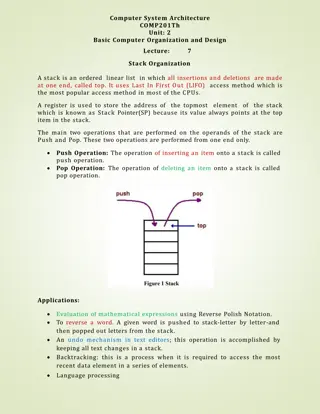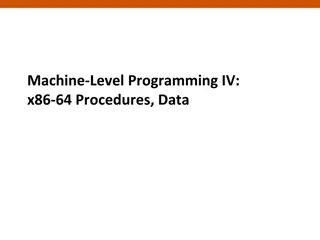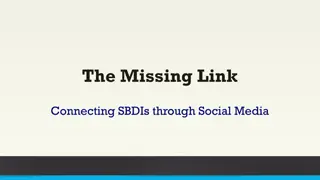Efficient Cloud Infrastructure for Facebook Image Stack
Facebook employs a sophisticated infrastructure to rapidly deliver images to its users, utilizing a blend of data centers, caching services, and smart algorithms. By strategically distributing resources and intelligently caching popular content, Facebook ensures quick and cost-effective image delivery even during peak loads. This architecture, outlined in CS5412.Spring.2015, showcases the scalability and efficiency necessary to serve millions of daily users.
Download Presentation

Please find below an Image/Link to download the presentation.
The content on the website is provided AS IS for your information and personal use only. It may not be sold, licensed, or shared on other websites without obtaining consent from the author.If you encounter any issues during the download, it is possible that the publisher has removed the file from their server.
You are allowed to download the files provided on this website for personal or commercial use, subject to the condition that they are used lawfully. All files are the property of their respective owners.
The content on the website is provided AS IS for your information and personal use only. It may not be sold, licensed, or shared on other websites without obtaining consent from the author.
E N D
Presentation Transcript
CS5412 Spring 2015 1 CLOUD-SCALE INFORMATION RETRIEVAL Ken Birman, CS5412 Cloud Computing
Styles of cloud computing 2 Think about Facebook We normally see it in terms of pages that are image- heavy But the tags and comments and likes create relationships between objects within the system And FB itself tries to be very smart about what it shows you in terms of notifications, stuff on your wall, timeline, etc How do they actually get data to users with such impressive real-time properties? (often << 100ms!) CS5412 Spring 2015
Facebook image stack 3 Role is to serve images (photos, videos) for FB s hundreds of millions of active users About 80B large binary objects ( blob ) / day FB has a huge number of big and small data centers Point of presense or PoP: some FB owned equipment normally near the user Akamai: A company FB contracts with that caches images FB resizer service: caches but also resizes images Haystack: inside data centers, has the actual pictures (a massive file system) CS5412 Spring 2015
Facebook architecture 4 Think of Facebook as a giant distributed HashMap Key: photo URL (id, size, hints about where to find it...) Value: the blob itself CS5412 Spring 2015
Facebook traffic for a week 5 Client activity varies daily.... ... and different photos have very different popularity statistics CS5412 Spring 2015
Observations 6 There are huge daily, weekly, seasonal and regional variations in load, but on the other hand the peak loads turn out to be similar over reasonably long periods like a year or two Whew! FB only needs to reinvent itself every few years Can plan for the worst-case peak loads And during any short period, some images are way more popular than others: Caching should help CS5412 Spring 2015
Facebooks goals? 7 Get those photos to you rapidly Do it cheaply Build an easily scalable infrastructure With more users, just build more data centers ... they do this using ideas we ve seen in cs5412! CS5412 Spring 2015
Best ways to cache this data? 8 Core idea: Build a distributed photo cache (like a HashMap, indexed by photo URL) Core issue: We could cache data at various places On the client computer itself, near the browser In the PoP In the Resizer layer In front of Haystack Where s the best place to cache images? Answer depends on image popularity... CS5412 Spring 2015
Distributed Hash Tables 9 It is easy for a program on biscuit.cs.cornell.edu to send a message to a program on jam.cs.cornell.edu Each program sets up a network socket Each machine has an IP address, you can look them up and programs can do that too via a simple Java utility Pick a port number (this part is a bit of a hack) Build the message (must be in binary format) Java utils has a request CS5412 Spring 2015
Distributed Hash Tables 10 It is easy for a program on biscuit.cs.cornell.edu to send a message to a program on jam.cs.cornell.edu ... so, given a key and a value Hash the key Find the server that owns the hashed value Store the key,value pair in a local HashMap there 1. 2. 3. To get a value, ask the right server to look up key CS5412 Spring 2015
Distributed Hash Tables 11 hashmap kept by 123.45.66.782 ( ken , 2110) dht.Put( ken ,2110) 123.45.66.781 123.45.66.782 123.45.66.783 123.45.66.784 ken .hashcode()%N=77 dht.Get( ken ) ken .hashcode()%N=77 CS5412 Spring 2015
How should we build this DHT? 12 DHTs and related solutions seen so far in CS5412 Chord, Pastry, CAN, Kelips MemCached, BitTorrent They differ in terms of the underlying assumptions Can we safely assume we know which machines will run the DHT? For a P2P situation, applications come and go at will For FB, DHT would run inside FB owned data centers, so they can just keep a table listing the active machines CS5412 Spring 2015
FB DHT approach 13 DHT is actually split into many DHT subsystems Each subsystem lives in some FB data center, and there are plenty of those (think of perhaps 50 in the USA) In fact these are really side by side clusters: when FB builds a data center they usually have several nearby buildings each with a data center in it, combined into a kind of regional data center They do this to give containment (floods, fires) and also so that they can do service and upgrades without shutting things down (e.g. they shut down 1 of 5 ) CS5412 Spring 2015
Facebook architecture 14 Think of Facebook as a giant distributed HashMap Key: photo URL (id, size, hints about where to find it...) Value: the blob itself CS5412 Spring 2015
Facebook cache effectiveness 15 Existing caches are very effective... ... but different layers are more effective for images with different popularity ranks CS5412 Spring 2015
Facebook cache effectiveness 16 Each layer should specialize in different content. Photo age strongly predicts effectiveness of caching CS5412 Spring 2015
Hypothetical changes to caching? 17 We looked at the idea of having Facebook caches collaborate at national scale and also at how to vary caching based on the busyness of the client CS5412 Spring 2015
Social networking effect? 18 Hypothesis: caching will work best for photos posted by famous people with zillions of followers Actual finding: not really CS5412 Spring 2015
Locality? 19 Hypothesis: FB probably serves photos from close to where you are sitting Finding: Not really... just the same, if the photo exists, it finds it quickly CS5412 Spring 2015
Can one conclude anything? 20 Learning what patterns of access arise, and how effective it is to cache given kinds of data at various layers, we can customize cache strategies Each layer can look at an image and ask should I keep a cached copy of this, or not? Smart decisions Facebook is more effective! CS5412 Spring 2015
Strategy varies by layer 21 Browser should cache less popular content but not bother to cache the very popular stuff Akamai/PoP layer should cache the most popular images, etc... We also discovered that some layers should cooperatively cache even over huge distances Our study discovered that if this were done in the resizer layer, cache hit rates could rise 35%! CS5412 Spring 2015
Overall picture in cloud computing 22 Facebook example illustrates a style of working Identify high-value problems that matter to the community because of the popularity of the service, the cost of operating it, the speed achieved, etc Ask how best to solve those problems, ideally using experiments to gain insight Then build better solutions Let s look at another example of this pattern CS5412 Spring 2015
Caching for TAO 23 Facebook recently introduced a new kind of database that they use to track groups Your friends The photos in which a user is tagged People who like Sarah Palin People who like Selina Gomez People who like Justin Beiber People who think Selina and Justin were a great couple People who think Sarah Palin and Justin should be a couple CS5412 Spring 2015
How is TAO used? 24 All sorts of FB operations require the system to Pull up some form of data Then search TAO for a group of things somehow related to that data Then pull up fingernails from that group of things, etc So TAO works hard, and needs to deal with all sorts of heavy loads Can one cache TAO data? Actually an open question CS5412 Spring 2015
How FB does it now 25 They create a bank of maybe 1000 TAO servers in each data center Incoming queries always of the form get group associated with this key They use consistent hashing to hash key to some server, and then the server looks it up and returns the data. For big groups they use indirection and return a pointer to the data plus a few items CS5412 Spring 2015
Challenges 26 TAO has very high update rates Millions of events per second They use it internally too, to track items you looked at, that you clicked on, sequences of clicks, whether you returned to the prior page or continued deeper So TAO sees updates at a rate even higher than the total click rate for all of FBs users (billions, but only hundreds of millions are online at a time, and only some of them do rapid clicks and of course people playing games and so forth don t get tracked this way) CS5412 Spring 2015
Goals for TAO [Slides from a FB talk given at Upenn in 2012] Provide a data store with a graph abstraction (vertexes and edges), not keys+values Optimize heavily for reads More than 2 orders of magnitude more reads than writes! Explicitly favor efficiency and availability over consistency Slightly stale data is often okay (for Facebook) Communication between data centers in different regions is expensive CS5412 Spring 2015 27
Images by Jojo Mendoza, Creative Commons licensed Thinking about related objects 28 Facebook fan-of fan-of fan-of Mikhail fan-of Magna Carta fan-of friend-of friend-of Jose Alice Sunita We can represent related objects as a labeled, directed graph Entities are typically represented as nodes; relationships are typically edges Nodes all have IDs, and possibly other properties Edges typically have values, possibly IDs and other properties CS5412 Spring 2015
TAO's data model Facebook's data model is exactly like that! Focuses on people, actions, and relationships These are represented as vertexes and edges in a graph Example: Alice visits a landmark with Bob Alice 'checks in' with her mobile phone vertexes and edges in the graph Alice 'tags' Bob to indicate that he is with her Cathy added a comment David 'liked' the comment CS5412 Spring 2015 29
TAO's data model and API TAO "objects" (vertexes) 64-bit integer ID (id) Object type (otype) Data, in the form of key-value pairs Object API: allocate, retrieve, update, delete TAO "associations" (edges) Source object ID (id1) Association type (atype) Destination object ID (id2) 32-bit timestamp Data, in the form of key-value pairs Association API: add, delete, change type Associations are unidirectional But edges often come in pairs (each edge type has an 'inverse type' for the reverse edge) CS5412 Spring 2015 30
Example: Encoding in TAO Data (KV pairs) Inverse edge types CS5412 Spring 2015 31
Association queries in TAO TAO is not a general graph database Has a few specific (Facebook-relevant) queries 'baked into it' Common query: Given object and association type, return an association list (all the outgoing edges of that type) Example: Find all the comments for a given checkin Optimized based on knowledge of Facebook's workload Example: Most queries focus on the newest items (posts, etc.) There is creation-time locality can optimize for that! Queries on association lists: assoc_get(id1, atype, id2set, t_low, t_high) assoc_count(id1, atype) "cursor" assoc_range(id1, atype, pos, limit) assoc_time_range(id1, atype, high, low, limit) CS5412 Spring 2015 32
TAO's storage layer Objects and associations are stored in mySQL But what about scalability? Facebook's graph is far too large for any single mySQL DB!! Solution: Data is divided into logical shards Each object ID contains a shard ID Associations are stored in the shard of their source object Shards are small enough to fit into a single mySQL instance! A common trick for achieving scalability What is the 'price to pay' for sharding? CS5412 Spring 2015 33
Caching in TAO (1/2) Problem: Hitting mySQL is very expensive But most of the requests are read requests anyway! Let's try to serve these from a cache TAO's cache is organized into tiers A tier consists of multiple cache servers (number can vary) Sharding is used again here each server in a tier is responsible for a certain subset of the objects+associations Together, the servers in a tier can serve any request! Clients directly talk to the appropriate cache server Avoids bottlenecks! In-memory cache for objects, associations, and association counts (!) CS5412 Spring 2015 34
Caching in TAO (2/2) How does the cache work? New entries filled on demand When cache is full, least recently used (LRU) object is evicted Cache is "smart": If it knows that an object had zero associ-ations of some type, it knows how to answer a range query Could this have been done in Memcached? If so, how? If not, why not? What about write requests? Need to go to the database (write-through) But what if we're writing a bidirectonal edge? This may be stored in a different shard need to contact that shard! What if a failure happens while we're writing such an edge? You might think that there are transactions and atomicity... ... but in fact, they simply leave the 'hanging edges' in place (why?) Asynchronous repair job takes care of them eventually CS5412 Spring 2015 35
Leaders and followers How many machines should be in a tier? Too many is problematic: More prone to hot spots, etc. Solution: Add another level of hierarchy Each shard can have multiple cache tiers: one leader, and multiple followers The leader talks directly to the mySQL database Followers talk to the leader Clients can only interact with followers Leader can protect the database from 'thundering herds' CS5412 Spring 2015 36
Leaders/followers and consistency What happens now when a client writes? Follower sends write to the leader, who forwards to the DB No! Does this ensure consistency? Need to tell the other followers about it! Write to an object Leader tells followers to invalidate any cached copies they might have of that object Write to an association Don't want to invalidate. Why? Followers might have to throw away long association lists! Solution: Leader sends a 'refill message' to followers If follower had cached that association, it asks the leader for an update What kind of consistency does this provide? CS5412 Spring 2015 37
Scaling geographically Facebook is a global service. Does this work? No - laws of physics are in the way! Long propagation delays, e.g., between Asia and U.S. What tricks do we know that could help with this? CS5412 Spring 2015 38
Scaling geographically Idea: Divide data centers into regions; have one full replica of the data in each region What could be a problem with this approach? Again, consistency! Solution: One region has the 'master' database; other regions forward their writes to the master Database replication makes sure that the 'slave' databases eventually learn of all writes; plus invalidation messages, just like with the leaders and followers CS5412 Spring 2015 39
Handling failures What if the master database fails? Can promote another region's database to be the master But what about writes that were in progress during switch? What would be the 'database answer' to this? TAO's approach: CS5412 Spring 2015 40 Why is (or isn't) this okay in general / for Facebook?
Consistency in more detail What is the overall level of consistency? During normal operation: Eventual consistency (why?) Refills and invalidations are delivered 'eventually' (typical delay is less than one second) Within a tier: Read-after-write (why?) When faults occur, consistency can degrade In some situations, clients can even observe values 'go back in time'! How bad is this (for Facebook specifically / in general)? Is eventual consistency always 'good enough'? No - there are a few operations on Facebook that need stronger consistency (which ones?) TAO reads can be marked 'critical' ; such reads are handled directly by the master. CS5412 Spring 2015 41
Fault handling in more detail General principle: Best-effort recovery Preserve availability and performance, not consistency! Database failures: Choose a new master Might happen during maintenance, after crashes, repl. lag Leader failures: Replacement leader Route around the faulty leader if possible (e.g., go to DB) Refill/invalidation failures: Queue messages If leader fails permanently, need to invalidate cache for the entire shard Follower failures: Failover to other followers The other followers jointly assume responsibility for handling the failed follower's requests CS5412 Spring 2015 42
Production deployment at Facebook Impressive performance Handles 1 billion reads/sec and 1 million writes/sec! Reads dominate massively Only 0.2% of requests involve a write Most edge queries have zero results 45% of assoc_count calls return 0... but there is a heavy tail: 1% return >500,000! (why?) Cache hit rate is very high Overall, 96.4%! CS5412 Spring 2015 43
TAO Summary The data model really does matter! KV pairs are nice and generic, but you sometimes can get better performance by telling the storage system more about the kind of data you are storing in it ( optimizations!) Several useful scaling techniques "Sharding" of databases and cache tiers (not invented at Facebook, but put to great use) Primary-backup replication to scale geographically Interesting perspective on consistency On the one hand, quite a bit of complexity & hard work to do well in the common case (truly "best effort") But also, a willingness to accept eventual consistency (or worse!) during failures, or when the cost would be high CS5412 Spring 2015 44
HayStack Storage Layer Facebook stores a huge number of images In 2010, over 260 billion (~20PB of data) One billion (~60TB) new uploads each week How to serve requests for these images? Typical approach: Use a CDN (and Facebook does do that) CS5412 Spring 2015 45
Haystack challenges 46 Very long tail: People often click around and access very rarely seen photos Disk I/O is costly Haystack goal: one seek and one read per photo Standard file systems are way too costly and inefficient Haystack response: Store images and data in long strips (actually called volumes ) Photo isn t a file; it is in a strip at off=xxxx len=yyyy CS5412 Spring 2015
Haystack: The Store (1/2) Volumes are simply very large files (~100GB) Few of them needed In-memory data structures small Structure of each file: A header, followed by a number of 'needles' (images) Cookies included to prevent guessing attacks Writes simply append to the file; deletes simply set a flag CS5412 Spring 2015 47
Haystack: The Store (2/2) Store machines have an in-memory index Maps photo IDs to offsets in the large files What to do when the machine is rebooted? Option #1: Rebuild from reading the files front-to-back Is this a good idea? Option #2: Periodically write the index to disk What if the index on disk is stale? File remembers where the last needle was appended Server can start reading from there Might still have missed some deletions - but the server can 'lazily' update that when someone requests the deleted img CS5412 Spring 2015 48
Recovery from failures Lots of failures to worry about Faulty hard disks, defective controllers, bad motherboards... Pitchfork service scans for faulty machines Periodically tests connection to each machine Tries to read some data, etc. If any of this fails, logical (!) volumes are marked read-only Admins need to look into, and fix, the underlying cause Bulk sync service can restore the full state ... by copying it from another replica Rarely needed CS5412 Spring 2015 49
How well does it work? How much metadata does it use? Only about 12 bytes per image (in memory) Comparison: XFS inode alone is 536 bytes! More performance data in the paper Cache hit rates: Approx. 80% CS5412 Spring 2015 50






















